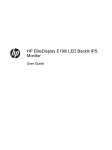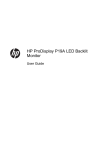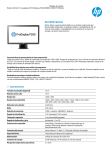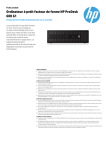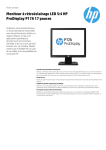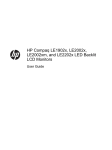Download HP P17A User's Manual
Transcript
HP ProDisplay P17A LED Backlit Monitor User Guide © 2013 Hewlett-Packard Development Company, L.P. Microsoft, Windows, and Windows Vista are either trademarks or registered trademarks of Microsoft Corporation in the United States and/or other countries. The only warranties for HP products and services are set forth in the express warranty statements accompanying such products and services. Nothing herein should be construed as constituting an additional warranty. HP shall not be liable for technical or editorial errors or omissions contained herein. This document contains proprietary information that is protected by copyright. No part of this document may be photocopied, reproduced, or translated to another language without the prior written consent of Hewlett-Packard Company. First Edition (November 2013) Document Part Number: 749664-001 About This Guide This guide provides information on setting up the monitor, installing drivers, using the on-screen display menu, troubleshooting and technical specifications. WARNING! Text set off in this manner indicates that failure to follow directions could result in bodily harm or loss of life. CAUTION: Text set off in this manner indicates that failure to follow directions could result in damage to equipment or loss of information. NOTE: Text set off in this manner provides important supplemental information. iii iv About This Guide Table of contents 1 Product Features ............................................................................................................................................ 1 HP Monitor ........................................................................................................................................... 1 2 Setting Up the Monitor ................................................................................................................................... 2 Attaching the Monitor Base .................................................................................................................. 2 Rear Components ................................................................................................................................ 3 Connecting the Cables ......................................................................................................................... 4 Front Panel Controls ............................................................................................................................ 5 Adjusting the Monitor ............................................................................................................................ 6 Turning on the Monitor ......................................................................................................................... 6 Using the Accessory Rails .................................................................................................................... 7 Removing the Monitor Pedestal Base .................................................................................................. 7 Mounting the Monitor ........................................................................................................... 8 Locating the Rating Labels ................................................................................................................... 9 Installing a Cable Lock ....................................................................................................................... 10 3 Finding More Information ............................................................................................................................. 11 Reference Guides .............................................................................................................................. 11 Product Support ................................................................................................................................. 11 Appendix A Technical Specifications ............................................................................................................ 12 ProDisplay P17A LED Backlit Monitor ................................................................................................ 12 Recognizing Preset Display Resolutions ............................................................................................ 13 Entering User Modes .......................................................................................................................... 13 Energy Saver Feature ........................................................................................................................ 14 v vi 1 Product Features HP Monitor The LCD (liquid crystal display) monitor has an active matrix, thin-film transistor (TFT) panel. The monitor's features include: ● 43.18 cm (17–inch) diagonal viewable area display with 1280 x 1024 resolution, plus full-screen support for lower resolutions: includes custom scaling for maximum image size ● Non-glare panel with an LED backlight ● Wide viewing angle to allow viewing from a sitting or standing position, or moving from side-toside ● Tilt capability ● Removable stand for flexible monitor panel mounting solutions ● Video signal input to support VGA analog (cable provided) ● Supports an optional HP speaker bar ● Plug and play capability if supported by the system ● Privacy filter slots to insert filters (purchased separately) to block side screen viewing ● Security slot provision on rear of monitor for optional cable lock ● On-Screen Display (OSD) adjustments in several languages for easy setup and screen optimization ● HP Display Assistant for adjusting monitor settings and enabling theft deterrence features ● Software and documentation disc that includes monitor drivers and product documentation ● Energy saver feature to meet requirements for reduced power consumption ● Intelligent Management AssetControl ● Compliant with the following regulated specifications (for additional certifications and agency notices, refer to the HP LCD Monitors Reference Guide on the disc included with this monitor): ◦ European Union CE Directives ◦ Swedish TCO Requirements HP Monitor 1 2 Setting Up the Monitor To set up the monitor, ensure that the power is turned off to the monitor, computer system, and other attached devices, then follow the instructions below. Attaching the Monitor Base 2 1. Set the base on a flat surface such as a table top. 2. Using both hands, position the pedestal over the base and press down firmly to lock it in place. Be sure the base is securely locked in place and adjust the tilt angle to the desired position. Chapter 2 Setting Up the Monitor Rear Components Component Function 1 AC Power Connector Connects the AC power cord to the monitor 2 VGA Connector Connects the VGA cable to the monitor Rear Components 3 Connecting the Cables 1. Place the monitor in a convenient, well-ventilated location near the computer. 2. Connect the VGA signal cable provided. 3. Connect one end of the power cord to the AC power connector on the back of the monitor, and the other end to an electrical wall outlet. WARNING! To reduce the risk of electric shock or damage to the equipment: Do not disable the power cord grounding plug. The grounding plug is an important safety feature. Plug the power cord into a grounded (earthed) electrical outlet that is easily accessible at all times. Disconnect power from the equipment by unplugging the power cord from the electrical outlet. For your safety, do not place anything on power cords or cables. Arrange them so that no one may accidentally step on or trip over them. Do not pull on a cord or cable. When unplugging from the electrical outlet, grasp the cord by the plug. 4 Chapter 2 Setting Up the Monitor Front Panel Controls Table 2-1 Monitor Front Panel Controls Control Function 1 Menu Opens, selects or exits the OSD menu. 2 Auto Adjustment/ Minus If the OSD menu is inactive, press to activate the auto adjustment feature to optimize the screen image. If the OSD menu is on, press to navigate backward through the OSD menu and decrease adjustment levels. 3 Plus If the OSD menu is on, press to navigate forward through the OSD menu and increase adjustment levels. 4 Power LED White = Fully powered. Amber = Sleep mode. Flashing Amber = Sleep Timer mode. 5 Power Turns the monitor on or off. NOTE: To view an OSD menu simulator, visit the HP Customer Self Repair Services Media Library at http://www.hp.com/go/sml. Front Panel Controls 5 Adjusting the Monitor Tilt the monitor's panel forward or backward to set it to a comfortable eye level. Turning on the Monitor 1. Press the power button on the computer to turn it on. 2. Press the power button on the front of the monitor to turn it on. CAUTION: Burn-in image damage may occur on monitors that display the same static image on screen for a prolonged period of time.* To avoid burn-in image damage on the monitor screen, you should always activate a screen saver application or turn off the monitor when it is not in use for a prolonged period of time. Image retention is a condition that may occur on all LCD screens. Monitors with a “burned-in image” are not covered under the HP warranty. * A prolonged period of time is 12 consecutive hours of non-use. NOTE: If pressing the power button has no effect, the Power Button Lockout feature may be enabled. To disable this feature, press and hold the monitor power button for 10 seconds. NOTE: You can disable the power LED in the OSD menu. Press the Menu button on the front of the monitor, then select Management > Bezel Power LED > Off. 6 Chapter 2 Setting Up the Monitor Using the Accessory Rails The monitor features accessory rails on the rear that can be used to mount optional devices, such as the HP speaker bar, to attach to the LCD. Refer to the documentation included with the optional device for detailed mounting instructions. Figure 2-1 Using the Accessory Rails Feature Removing the Monitor Pedestal Base You can remove the monitor panel from the pedestal base to install the panel on a wall, a swing arm, or other mounting fixture. CAUTION: Before beginning to disassemble the monitor, be sure the monitor is turned off and the power and signal cables are both disconnected. Also disconnect all USB cables connected to the monitor. 1. Disconnect and remove the signal, power, and USB cables from the monitor. 2. Lay the monitor face down on a flat surface covered by a clean, dry cloth. Using the Accessory Rails 7 3. Remove the three screws from the back of the monitor that connect the monitor panel to the pedestal base (1), and then slide the pedestal base from the monitor panel (2). Mounting the Monitor The monitor panel can be attached to a wall, swing arm, or other mounting fixture. NOTE: 1. This apparatus is intended to be supported by UL or CSA Listed wall mount bracket. Remove the monitor panel from the pedestal base. Refer to Removing the Monitor Pedestal Base on page 7. CAUTION: This monitor supports the VESA industry standard 100 mm mounting holes. To attach a third-party mounting solution to the monitor, four 4 mm, 0.7 pitch, and 10 mm long screws are required. Longer screws must not be used because they may damage the monitor. It is important to verify that the manufacturer’s mounting solution is compliant with the VESA standard and is rated to support the weight of the monitor display panel. For best performance, it is important to use the power and video cables provided with the monitor. 8 Chapter 2 Setting Up the Monitor 2. To attach the monitor to a swing arm, insert four 10mm screws through the holes on the swing arm plate and into the mounting holes on the monitor. To attach the monitor to other mounting fixtures, follow the instructions included with the mounting fixture to ensure that the monitor is safely attached. 3. Reconnect the cables to the monitor panel. Locating the Rating Labels The rating labels on the monitor provide the spare part number, product number, and serial number. You may need these numbers when contacting HP about the monitor model. The rating labels are located on the rear panel of the monitor display head. Locating the Rating Labels 9 Installing a Cable Lock You can secure the monitor to a fixed object with an optional cable lock available from HP. 10 Chapter 2 Setting Up the Monitor 3 Finding More Information Reference Guides Refer to the HP LCD Monitors Reference Guide included on the disc with your monitor for additional information on: ● Optimizing monitor performance ● Safety and maintenance guidelines ● Installing software from the disc ● Using the OSD menu ● Downloading software from the Web ● Agency regulatory information ● Troubleshooting and recommended solutions to common problems For information on theft deterrence, refer to the HP Display Assistant User Guide included on the disc with your monitor. Product Support For additional information on using and adjusting your monitor, go to http://www.hp.com/support. Select your country or region, select Drivers and Downloads, and then enter your monitor model in the Find by Product search field. NOTE: The monitor user guide, reference guide, and drivers are available at http://www.hp.com/ support. If the information provided in the guide or in the HP LCD Monitors Reference Guide do not address your questions, you can contact support. For U.S. support, go to http://www.hp.com/go/contactHP. For worldwide support, go to http://welcome.hp.com/country/us/en/wwcontact_us.html. Here you can: ● Chat online with an HP technician NOTE: When support chat is not available in a particular language, it is available in English. ● Find support telephone numbers ● Locate an HP service center Reference Guides 11 A Technical Specifications NOTE: All specifications represent the typical specifications provided by HP's component manufacturers; actual performance may vary either higher or lower. ProDisplay P17A LED Backlit Monitor Table A-1 ProDisplay P17A LED Backlit Monitor Specifications Display Type LED Backlit Viewable Image Size 43.18 cm diagonal Aspect Ratio 5:4 Tilt -5 to 25° Maximum Weight (Unpacked) 3.72 kg 17–inch diagonal 8.20 lbs Dimensions (include base) Height 38.72 cm Depth 37.72 cm Width 20.63cm Maximum Graphic Resolution 1280 x 1024 (60 Hz) Optimum Graphic Resolution 1280 x 1024 (60 Hz) Text Mode 720 × 400 Dot Pitch 0.264 (H) × 0.264 (W) mm Pixels Per Inch 96 PPI Horizontal Frequency 24 to 83 kHz Vertical Refresh Rate 50 to 76 Hz 15.24 inches 14.85 inches 8.12 inches Environmental Requirements Temperature Operating Temperature 5 to 35° C 41 to 95° F Storage Temperature -20 to 60° C -4 to 140° F Relative Humidity 20 to 80% Power Source 100 – 240 VAC 50/60 Hz Altitude: 12 Operating 0 to 5000 m 0 to 16,400 feet Storage 0 to 12192 m 0 to 40,000 feet Appendix A Technical Specifications Table A-1 ProDisplay P17A LED Backlit Monitor Specifications (continued) Measured Power Consumption: Full Power 20 watts Typical Settings 15.2 watts Sleep <0.5 watts Switch Off <0.5 watts Input Terminal One VGA connector (cable included) NOTE: For the latest specifications or additional specifications on this product, go to http://www.hp.com/go/productbulletin/ and search for your specific display model to find the modelspecific QuickSpecs. Recognizing Preset Display Resolutions The display resolutions listed below are the most commonly used modes and are set as factory defaults. This monitor automatically recognizes these preset modes and they will appear properly sized and centered on the screen. Table A-2 ProDisplay P17A Factory Preset Modes Preset Pixel Format Horz Freq (kHz) Vert Freq (Hz) 1 640 × 480 31.469 59.940 2 720 × 400 31.469 70.087 3 800 × 600 37.879 60.317 4 1024 × 768 48.363 60.004 5 1280 x 720 45.000 60.000 6 1280 x 800 49.306 59.910 7 1280 × 960 60.00 60.00 8 1280 × 1024 63.98 60.02 Entering User Modes The video controller signal may occasionally call for a mode that is not preset if: ● You are not using a standard graphics adapter. ● You are not using a preset mode. It this occurs, you may need to readjust the parameters of the monitor screen by using the on-screen display. Your changes can be made to any or all of these modes and saved in memory. The monitor automatically stores the new setting, then recognizes the new mode just as it does a preset mode. In addition to the factory preset modes, there are at least 10 user modes that can be entered and stored. Recognizing Preset Display Resolutions 13 Energy Saver Feature The monitors support a reduced power state. The reduced power state will be entered into if the monitor detects the absence of either the horizontal sync signal and/or the vertical sync signal. Upon detecting the absence of these signals, the monitor screen is blanked, the backlight is turned off, and the power light is turned amber. When the monitor is in the reduced power state, the monitor will utilize .5 watts of power. There is a brief warm up period before the monitor will return to its normal operating mode. Refer to the computer manual for instructions on setting energy saver features (sometimes called power management features). NOTE: The above power saver feature only works when connected to computers that have energy saver features. By selecting the settings in the monitor's sleep timer utility, you can also program the monitor to enter into the reduced power state at a predetermined time. When the monitor's sleep timer utility causes the monitor to enter the reduced power state, the power light blinks amber. 14 Appendix A Technical Specifications




















